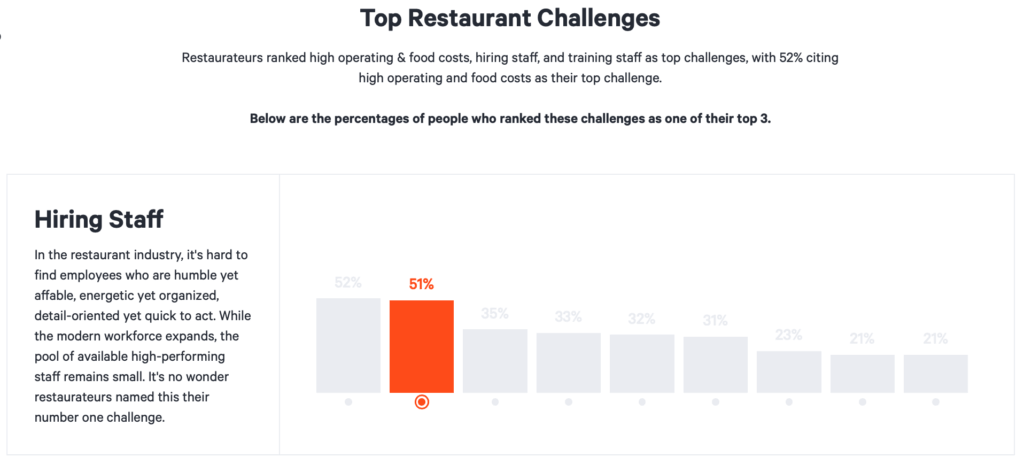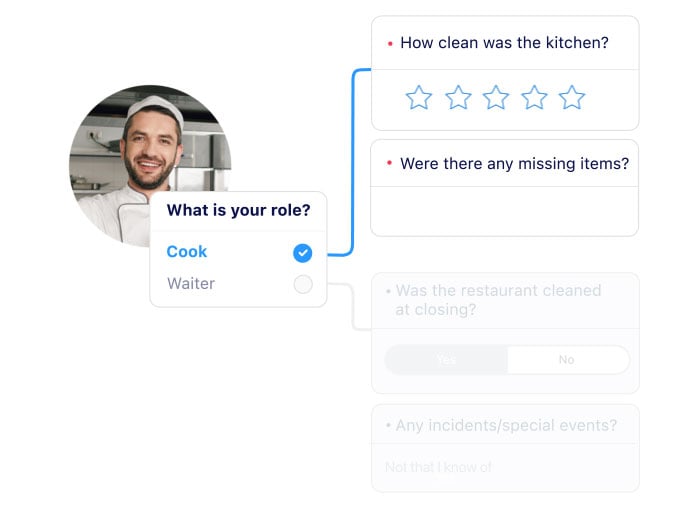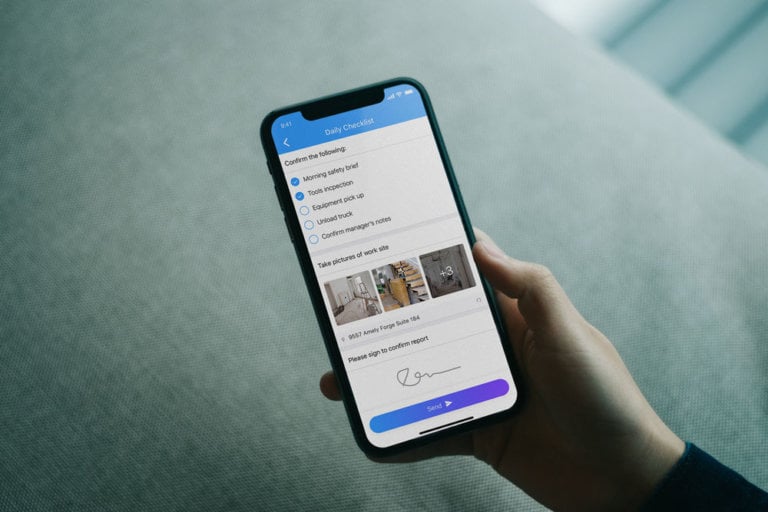See how HR policies for restaurants go a lot deeper than the dress code. Find out what you could be doing to ensure your restaurant is on the map with these HR policy examples and guides!
Even if you know nothing about running a local cafe or a large international chain, everyone knows that the dishes have to be tasty. The restaurant should be clean with a warm, fun ambiance. And the staff, well, they need to be friendly!
However, if you do run your own restaurant and you don’t have effective employee management for it, then it’s highly likely your diners won’t be returning. Even if Gordon Ramsay is your chef!
Therefore, what I’m about to tell you may come as an absolute shock, but 70% of employees within the foodservice industry haven’t received training on customer service.
This is why it’s imperative that you have restaurant policies and procedures in place.
But, just like many restaurant owners and managers, you’re left wondering:
- How do I create clear and robust HR policies? And, how can I ensure my staff respect and follow them?
- How do I make sure employees are engaged and motivated?
- What’s the best way to provide employees with all the data and knowledge they need?
- How can I reduce employee turnover and become a restaurant people actually want to work for?
- Would it be easier to automate the recurring procedures and optimize workflows? How do I do that?
- What’s the best tool to provide immediate updates and make sure people actually get them?
HR policies are what keeps your team in line and keeps the quality of service high. This is regardless of the size of your restaurant.
Connecteam – The #1 Employee Management App
Digitize your training and HR policies and keep your employees for the long haul!
Your Staff Is As Important As Your Food
Of course, your food is important. Without good food, you are looking at the staff, chefs, waiters, and tables!
However, there are two very important reasons why your workers are on the same level as your dishes.
Your Employees are the Face and Voice of Your Business.
They say your business is only as good as your worst employee and it is very true.
Therefore, you must have restaurant policies and procedures in place, to ensure your staff is up to par.
Let’s be honest, if you order good food and it arrives fast, there’s no need to go to a restaurant. In fact, 38% of consumers say they are more likely to order food than they were two years ago. And after COVID-19, even places that never considered offering a delivery service are doing so.
So when people actually go to a restaurant, they go there for the experience, which is much more than just a great menu.
You may have the best meals in town, however, if your guests feel unwelcome, and your staff barely interact, your customer might be out the door before their meal even reaches their plate.
Some customers will put up with terrible service, but whether they’ll return is another thing. Therefore, it’s imperative that restaurant policies and procedures are put in place along with adequate training.
It’s All Operational. Your Restaurant’s Staffing Strategy, HR Policies, and Procedures Matter.
There is a direct link between the hiring strategy and restaurant turnover. Reports show that the turnover rate for fast food restaurants is at a whopping 144%. This means MOST restaurant staffers don’t see the value in staying for the long term. The main reasons include low pay, tough hours, and not feeling appreciated or valued by the restaurant managers.
However, most restaurateurs name hiring as their biggest challenge to success.
In a recent Restaurant Industry Report, most restaurant owners and restaurant HR managers named employee hiring & training as their second and third biggest challenges with 51% and 35% respectively.

Employee turnover is not only expensive, but it makes other members in the team feel uncertain about their position. Plus, replacing one hourly employee costs around $1,500. So, it’s worth it to get right the first time around!
Therefore, it’s not surprising that HR policies for restaurants are one of the biggest challenges to date. But what are these key HR policies for restaurants? We answer that below, and more.
Examples of Restaurant Policies & Procedures
Law & Order
When you begin writing your restaurant policies and procedures you need to ensure you are complying with the law. You can’t skip those, since ignoring labor laws can get you in trouble with the law.
You should probably consult with your lawyer to get an up-to-date list of must-have policies in your state.
Note that many federal and state laws only apply to businesses with a certain number of employees. So check which regulations apply to you as your operation expands.
HR policies for restaurant required by federal law:
- Work hours
- Worker’s compensation
- Medical leave
- Discrimination
- Pay
Additionally, the following are policies that are required in some states. However, they are useful to have even if they don’t apply:
- Termination of employment
- Harassment
Sexual harassment is important to cover in your restaurant policies and procedures. This is because unfortunately, the restaurant industry is notorious for having the highest amount of sexual harassment claims.
So it’s crucial that you show your employees from day one that you have a zero-tolerance against sexual (and other types of) harassment. It’s crucial that you make the policy known and clear to your employees.
Keeping It Clean (and Safe)

It goes without saying that a food establishment requires food safety policies.
Sure, you can check the expiration dates regularly, and make sure the forks are clean, but that’s not enough!
You need to pass on your knowledge of the local government requirements when preparing and serving food. Be sure to outline the policies in your employee handbook. Additionally, place signs around your establishment, for example, a wash your hands sign in the bathrooms.
Food safety laws are there to protect your customers. However, you also want to keep your employees safe, and having clear policies can assist. For example, you might want to require employees to wear non-slip shoes, especially in the kitchen.
Some policies can save lives and prevent you from being involved in unwanted lawsuits.
Minimum Wage and Tips
The current federal minimum wage is $7.25 per hour and has not gone up since July 2009. However, there are some states, cities, and counties that impose a higher minimum wage rate.
In addition, when the state, city, or county minimum wage rate is higher than the federal rate, the employer is obligated to pay their workers the higher amount. However, we need to make clear that the minimum wage for tipped workers is actually lower than the regular minimum wage. But that does not mean under any circumstance that employers can pay tipped workers less than regular staff.
The Fair Labor Standards Act mandates that any employee who earns $30 or more per month in tips must be paid at least $2.13 in wages. Therefore, a waiter, bartender, or another service employee who does receive tips, then your employer is only required to pay you $2.13 per hour in wages. With that in mind, the total amount earned ($2.13/hour plus tips) must equal the federal minimum wage. As far as HR policies for restaurants go, this one is pretty key.
A Professional Presence

Dress code policies are important even if you don’t have branded uniforms for your employees. Some aspects of the dress code have to do with safety and hygiene rules (like non-slip shoes and hair-nets).
Others are mostly for professionalism. For example, you might want all your servers to wear a uniform, while the bartender is required to just look presentable without a formal dress code.
Just as your offline business needs to be up to scratch, your online presence should be too. A negative Yelp review can do some damage (as can a negative Glassdoor review!).
However, when something goes viral for the wrong reasons, it’s a whole different ball game. If you remember the taco-licking incident, you know that hurt the Taco Bell brand.
Feeding Your Employees
If you choose to feed your restaurant employees, that’s actually an easy way to boost the value of the job and can even help lower your turnover rate.
However, ensure that you create policies around what meals employees can and cannot eat. For example, if a dish calls for expensive ingredients then that’s probably one you don’t want your staff to eat so be clear on the rules.
Another idea is to create an employee of the month problem where the winner gets to choose one of the more expensive meals. (Totally up to you and your budget!)
Additionally, it’s not a bad idea to allow your employees to take food home. Especially the dishes created that you couldn’t sell. It’s a win-win! You minimize waste while your employee gets free food.
Drug Policy
Drug abuse is an epidemic many countries are facing, therefore you should make sure that your restaurant has a clear substance abuse policy.
Ensure that your employee knows what the expectations are, and frequently remind them of how important following the policy is. You should explain the consequences of breaking the rule.
How you want to set up the policy is up to you – some restaurants have zero tolerance and may perform surprise drug testing. Other restaurants don’t allow any form of drug abuse that impairs the individual to the point that it dissatisfies customers, reduces employee effectiveness, and can even lead to a dangerous situation for clients and staff.
Employees must know the consequences should they violate drug HR policies for restaurants. The disciplinary action needs to be a harsh warning or instant fire.
Onboarding Checklist

Employee onboarding is the process your business takes in order to properly welcome a new employee to the team and its culture. If done correctly, you have a higher chance of retaining employees and boosting engagement.
As such, you can follow these tips to ensure successful onboarding:
- Take your time. Training takes time, so don’t rush it because studies have shown that 31% of new hires leave within the first six months and 68% of those leave within three months. Why? Because they’re still learning the ropes. That includes how the company operates, where they fit in, and more. Processing that much information takes time so make sure the onboarding process is not rushed and lasts adequate time.
- Set clear goals. Create clear goals and frequently check in to assess the progress, this helps the new hire focus on what’s needed and their target. Don’t confuse the new hire so they’re running around aimlessly. Instead be clear to avoid confusion and to make sure they deliver on the goals you set forth. After all, no one is a mind reader.
- Have veteran/seasoned mentors. A survey discovered that 56% of employees believe having a work mentor is key when first starting out. A mentor helps break down the day-to-day grind, explains how management works, and is available to answer those “stupid questions”. By having a mentor, the new hire feels happier and on track.
- Get feedback. After the first day, the first week, and the first month, be sure to ask the new hire for feedback on their onboarding experience. By gaining feedback, you are able to make changes accordingly, so every time someone new joins the team, they are exposed to the top training methods.
How To Digitally Create New HR Policies For Restaurants
So at this point, you’re probably thinking that it’s going to take a lot of paperwork to create all those HR policies for your restaurant employees? Actually, there’s no need. Everyone has a mobile phone, so use it!
Connecteam is the leading HR management solution food and beverage managers and owners turn to in order to efficiently maintain all restaurant policies and procedures.
Connecteam’s key HR features include:
- Easily train and onboard your employees: With Connecteam’s employee training software, you can onboard your employees straight from their mobile devices by sharing policies, covering everything from compensation and pay to discrimination and termination of employment. Either remotely onboard new employees with customized training programs, or train existing employees on new policies or rules.
- Create and customize quizzes: Ensure that your employees completely understand every policy with Connecteam’s online quiz app. Evaluate your employees’ knowledge and provide instant feedback directly from the app.
- All employees’ documents can be found in one place: HR managers can use the documents feature to upload and manage all types of documents with minimal effort, including certificates, licenses, W4 forms, and more. You no longer need to search through piles of paper documents, saving tons of time in the process.
It’s also worth mentioning that Connecteam provides many other invaluable features that HR managers can use to improve their restaurant. For example, you can use the employee recognition and rewards to recognize employees for upholding policy or shine some light on your new hires.
Also, Connecteam’s timeline feature allows HR managers to manage and evaluate all employees. Easily keep track of everyone’s employment milestones, both past, present and future – making annual reviews and salary raises easy to determine.
Frequently Asked Questions On HR Policies For Restaurants
What Should I Include In My Restaurant Policies and Procedures?
Creating effective and legally compliant HR policies for a restaurant (or any organization, really) is a unique process. So it’s up to you to recognize the full needs of your restaurant.
Take the time to consider which policies match your business and its direction. Remember that your restaurant is its own unique dish, and you need to consider what goes into it.
What Should I Include In My Employee Handbook?
Here’s the thing, you don’t want your employee handbook turning into a novel-length saga. But you also don’t want to miss important guidelines unique to your business, like the Code of Conduct.
For example, if you’re planning to grow your team and offer promotions over time, having a detailed policy helps. Not only will it give your employees an incentive to excel, but it will also help retain them longer. Most importantly you keep the knowledge and experience in your business.
The employee handbook is one of the most popular examples of the HR policy documents used in this industry, about 68% of all restaurants offer it to their new hires.
An employee handbook is usually presented to the new staff member before they actually start working. The handbook prepares new employees for their new job and respective responsibilities. However, it also assists newbies to feel comfortable and welcome at your company.
The handbook covers the following:
- Basics of Employment
- Workplace Policies
- Code of Conduct
- Compensation
- Benefits and Perks
- Working Hours, PTO and Vacation
- Resignation and Termination
As Part of HR Policies for Restaurants, How Do I Onboard New Hires?
Another workplace policy document widely used for restaurant staff includes a new hire checklist, also called an onboarding checklist. A typical new hire checklist template usually includes:
- Employee benefits documents
- Employment forms required by law
- Employee contract
- IT department details
- HR department
- Stationery
- Obtain employees’ personal data for emergencies
Bottom Line On HR Policies For Restaurant Employees
The restaurant business is all about the experience guests receive. Therefore, you have to nail your recruitment strategy, training, and HR policies. Figuring out your restaurant policies and procedures is just as important as finding a great chef and creating a winning menu.
HR policies and procedures registered in the form of digital forms and checklists help HR managers and business owners set clear rules and expectations for the staff to follow. In addition, it holds workers accountable for their actions.
Most restaurants employ young people as it goes young people are tech-savvy. They use smartphones/tablets the way we understand pen and paper. They definitely are not used to sitting through hours of paperwork. So, switching all the HR-related and professional interactions to an all-in-one mobile employee app is the only way to go in 2025!
Join Thousands Of Restaurants Who Trust Connecteam
Schedule, customize workflows, onboard new employees, communicate with employees via the in-app chat and so much more!




